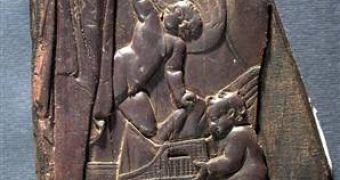Previously, Roman thrones were known only from paintings or as made of marble. But now researchers have discovered the first ever surviving Roman throne in the lava and ash that buried the city of Herculaneum, during the 79 AD eruption of the volcano Vesuvius (which destroyed also Pompeii and Stabiae), 82 ft (27 m) underground.
The wood and ivory throne is the most important furniture piece ever encountered at Herculaneum. The throne has been discovered during excavations in the Villa of the Papyri, the private house which belonged to Julius Caesar's father-in-law, Lucius Calpurnius Piso Caesoninus, and which had been constructed on the slope of Mount Vesuvius.
The villa got its name because of the impressive collection of thousands of scrolls of papyrus found buried under meters of volcanic ash. The restorers are now accomplishing the painstakingly task of remaking the ceremonial chair piece by piece. Two legs and part of the back of the wooden throne were dug out, in between October and November. Other wooden furnitures have also been found in nearby Pompeii, but this has been the most significant ceremonial piece.
"The find of ancient wooden furniture is not an absolute novelty in Herculaneum or Pompeii. Organic materials in fact were preserved in these cities because of the peculiar way in which they were submerged by the Vesuvius volcanic mud. But we have never found furniture of such a significant structure and decoration," said the head of the dig, Maria Paola Guidobaldi. "It's the first original throne from Roman times that has survived until today," said Pietro Giovanni Guzzo, Pompeii's archaeological superintendent.
How the throne was employed is not very well known, but its complicated decorations point that it was used in the mysterious cult of Attis, a life-death-rebirth god (somehow like the Greek god Dionysus). The main ivory relief depicts Attis, collecting a pine cone next to a sacred pine tree. Other ornaments represent leaves, flowers and phalluses, pointing to the theme of spring and fertility.
The documents of the time show that the cult of Attis was strong at that time in Herculaneum.

 14 DAY TRIAL //
14 DAY TRIAL //